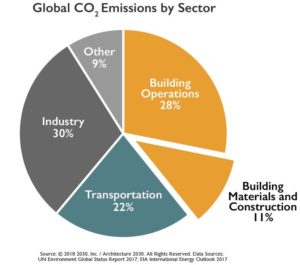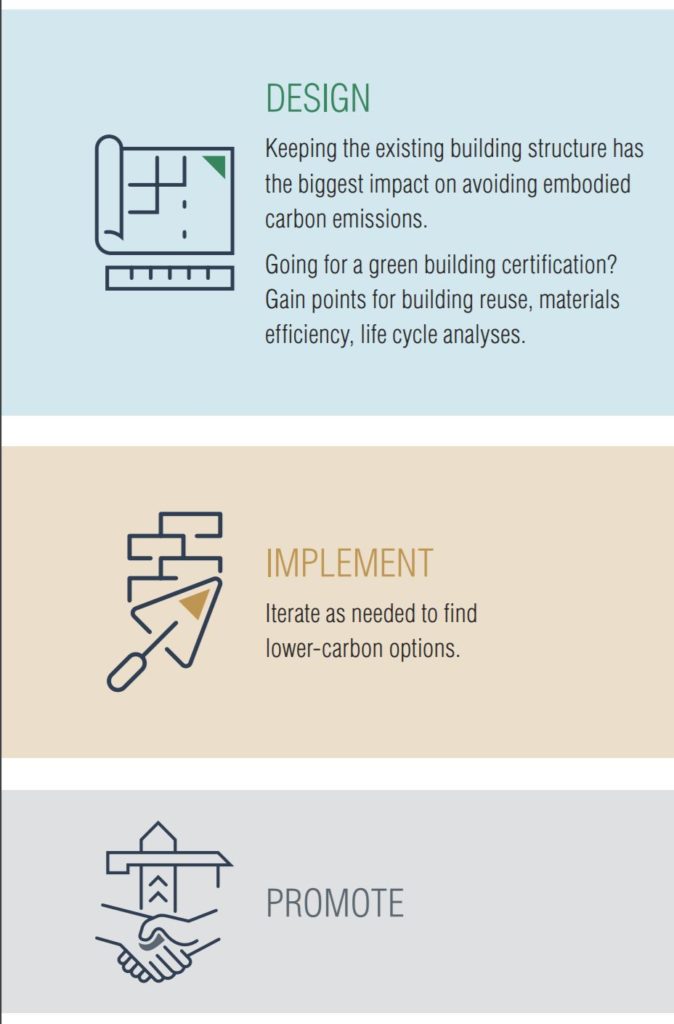Increasing urgency among policymakers and the design community to meet the goals of the Paris Climate Accord has spurred more aggressive codes and energy policies in jurisdictions around the United States. These strategies are making gains on driving down carbon emissions resulting from powering our homes and commercial buildings. Yet another source of carbon — embodied carbon — has gone largely unaddressed. Now through initiatives such as the Carbon Leadership Forum at the University of Washington and Architecture 2030, new attention is being paid to carbon emissions created during the manufacture, transport and construction of building materials (core and shell).
NBI recently curated a resource hub dedicated to providing guidance and tools that help building professionals address how much carbon is emitted through the making of materials such as concrete, steel, flat glass and types of insulation.
Why embodied carbon matters
Buildings account for 39% of global energy-related carbon emissions worldwide: 28% from operational emissions (from energy needed to heat, cool and power them), and the remaining 11% from materials and construction.* Policymakers, designers and builders have been implementing voluntary as well as mandatory strategies aimed at reducing the energy use and carbon emissions associated with building operations by focusing on building envelope, lighting, heating, ventilation, cooling, and equipment. In the future, as carbon emissions from building operations continue to decrease, embodied carbon will account for a larger and larger share of the emissions from new buildings.
Unlike building operations emissions, the embodied carbon of existing buildings occurs at the construction phase and are essentially “embedded” in the building walls, windows, girding and surfaces. Owners can address carbon from building operations on a periodic basis by upgrading lighting, mechanical systems and other equipment, but once a concrete floor is poured or ceiling tiles are installed, the carbon emitted during the manufacture and transport of those materials can never be recovered.
In response to the climate crisis more and more designers, builders and, developers are expected to seek out low-carbon building materials. For example, interest in cross-laminated timber, an alternative to concrete and steel, is showing growth in Europe and some parts of the United States. You can find examples of mass timber construction from New York to Minneapolis to Portland.
In 2017, California Governor Jerry Brown signed into law the Buy Clean California Act (AB 262), which requires contractors bidding on state infrastructure and construction projects to disclose the greenhouse gas emissions for four construction materials (structural steel, carbon steel rebar, flat glass and mineral wool board insulation). The law omitted concrete. On February 10, the city of Los Angeles became the first in California to formally adopt the Act as part of Mayor Eric Garcetti’s new Executive Directive calling for Zero Carbon Building. Berkeley, Cupertino and Richmond have endorsed the Act and are investigating whether to adopt.
The City of Portland, starting Jan. 1, 2020, requires contractors bidding on City construction projects to disclose product specific Environmental Product Declarations and use these to lower the greenhouse gas emissions of concrete.
In November 2019, Marin County became the first jurisdiction to approve a low-carbon code, which adds a low-carbon concrete specification to the Marin County Building Code. The code includes pathways for compliance with either reduced cement levels or lower-emission supplementary cementitious materials, such as fly ash.
Putting good intentions into practice
For practitioners working to deliver zero carbon buildings, addressing embodied carbon represents an important and new frontier. “In order for action to scale, we need easy to access data and tools,” said Kate Simonen, of the Carbon Leadership Forum.
While designers can use energy modeling software to estimate the carbon emissions of building operations, the industry has lacked a standardized system to track the carbon embedded in construction materials. The development of open-source tools such as Athena Impact Estimator, the Bath Inventory of Carbon and Energy (ICE), Tally, One Click LCA, and most recently the Embodied Carbon in Construction Calculator (EC3), is making it easier. These tools help design teams and owners better understand the levels of carbon locked in the structures they create.
EC3, which was incubated by the Carbon Leadership Forum, was a collective effort involving more than 50 organizations. Open source tools such as EC3 allow designers to find and compare various materials such as concrete, steel, wood, glass, aluminum, insulation, gypsum, carpet, and ceiling tiles. Having access to this data can help design teams make more informed decisions about the materials that will be “locked up” in buildings for decades to come.
The Urban Land Institute recently released a guide aimed at helping real estate professionals understand the growing urgency around measuring embodied carbon and suggests pathways for achieving reductions in embodied carbon in both new and existing buildings. High-level recommendations in “Embodied Carbon in Building Materials for Real Estate” include:
 Consider low-carbon structural materials.
Consider low-carbon structural materials.
80% of a building’s embodied carbon is from structural materials; consider low-carbon options like green concrete, recycled steel, or mass timber.
Reduce total materials in building design.
Fewer materials can result in lower costs.
Think sleek lines, exposed ceiling, buffed cement floors.
Repurpose used materials as much as possible. Repurposed materials can add marketing mileage and authenticity to a project.
Spec low-carbon products in the request for proposal.
Often lower-carbon materials are priced at no incremental cost. Calculate the embodied carbon of the materials. Tools exist to make this easier than ever before, and buildings will be prepared for eventual embodied carbon reporting regulations.
Share the story with others.
Gain community goodwill and grow market awareness/adoption of reduced embodied carbon.
Staying above the policy curve
In the absence of federal leadership to address climate change, more than 400 U.S. Climate Mayors representing more than 70 million Americans have adopted the goals of the Paris agreement for their cities. With buildings accounting for such a large percentage of the world’s greenhouse gas emissions, the built environment will continue to be an area of interest for these forward-thinking cities. However, further understanding of embedded carbon and continued refinement of tools will be necessary to develop codes that fundamentally reduce embodied carbon, rather than encouraging teams to simply do “less bad” with marginally better cementitious materials.
Organizations that take the time now to learn about embodied carbon and take steps to implement low-embodied carbon design practices will be well positioned in the future when it becomes incentivized by voluntary or mandatory policy measures.
*According to the World Building Council, Alliance for Building and Construction and Architecture 2030.
by Amy Cortese, Director of Programs
